Japanese coffee culture / Tokyo
Reportage 2. Bean and gone: Tokyo cafés
Look past the dominance of the big chains in Tokyo and you will find a world of fiercely independent coffee shops that are keeping tradition alive – but only just.
There are many remarkable things about Ichiro Sekiguchi – among them his vivid recall of the 1923 earthquake that all but razed Tokyo – but perhaps the most remarkable is that at the age of 100 he runs Café de l’Ambre, one of the most admired coffee shops in Tokyo. He still travels to work on the back of his nephew’s scooter to oversee the establishment he opened in 1948. It’s an unassuming place on a Ginza back street with a sign announcing “coffee only”. Sekiguchi might not put in the hours standing behind the counter these days – “My legs aren’t up to it!” – but he still roasts the beans at the front of the café twice a week and credits his passion for his work, along with three sugarless demitasses a day, for his energy levels. “I’m not thinking of retiring,” he says. “I’m happy to see the customers – I’ve met so many interesting people over the years.”
People think of Japan as a tea-drinking country but it is also one of the biggest consumers of coffee in the world. The Japanese have been drinking the stuff since missionaries and traders arrived with it in the 17th century; the world’s first coffee chain, Paulista, started in Tokyo and Osaka in 1910. Today Japan is the world’s third-largest importer of coffee – more than 500,000 tonnes arrived in 2013 – and a country whose rarefied tastes and high production values have shaped the coffee industry.
Central to this growth has been the kissaten, the coffee shop, which evolved as Japan started to urbanise at the end of the 19th century. There are about 70,000 of them in Japan – down from nearly 155,000 in 1985 – ranging from smoky station pit-stops to specialist affairs where the master precision-brews and hand-filters each cup. There are jazz kissa, literary bungaku kissa lined with books and meikyoku kissa: classical music cafés where listening to music is the purpose and talking is frowned upon. The kissaten has always offered a democratic space. People are there for different reasons: business, dates, filling out job applications, idling before a train. For some they are a refuge from the obligations of daily life. For others they offer company, conversation and community. This unique culture predates the global dominance of the big coffee chains.
Ichiro Sekiguchi, who was born in Asakusa in 1914, is the don of Tokyo’s kissaten masters. When he opened his coffee shop, Tokyo was still suffering the aftereffects of the war. Ginza, now glamorous and gilded, was then, he recalls, “nothing but bombsites and fields”. Coffee was in short supply and what was available was snapped up by the occupying US military. “Camp coffee was everywhere – and it was terrible, weak, I didn’t drink it,” he says. Sekiguchi, whose first taste of coffee was in Tokyo’s old milk halls where “coffee milk” was served, sourced a cache of decent coffee beans from Indonesia on the black market; they had been destined for Germany but got stuck in Japan. Word spread that Sekiguchi was serving good coffee and his future was set.
The original café burned down and Sekiguchi moved to his current location in about 1970. Like all the best kissaten Café de l’Ambre is a comforting, unpretentious place, where regulars (a couple of whom have been coming for 60 years) are welcomed as friends. Music hums in the background and photographs of Sekiguchi’s sisters sit on the till. He has four members of staff including his niece and her husband, who has already put in 35 years at the café.
Sekiguchi’s coffee-making style has brought many pilgrims and coffee maniacs – as the Japanese call them – to his door. Like many kissaten owners, he eschews espresso machines and complicated siphons in favour of a cloth “nel” (short for “flannel”) filter and a pot of hot water. “There’s so much equipment available but this [hand-drip] is the best way to serve coffee,” he says. Beans are roasted and ground for each cup of coffee ordered. One of the staff weighs out 18g on the scales and grinds them; there follows a dance with filters, jugs and boiling water. It’s all done with humour and conversation.


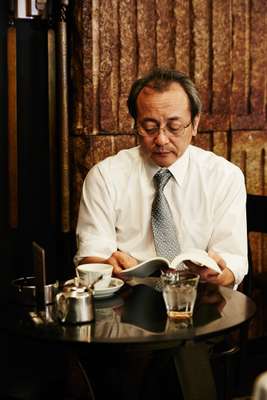

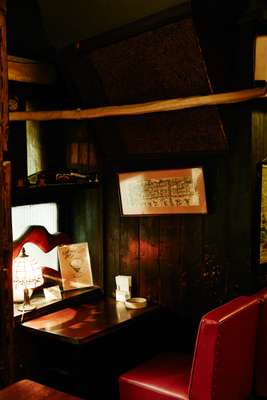
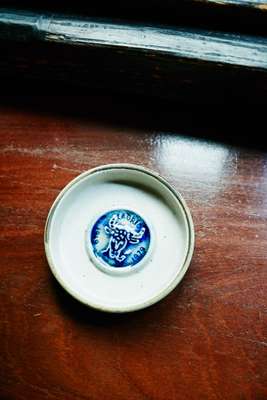

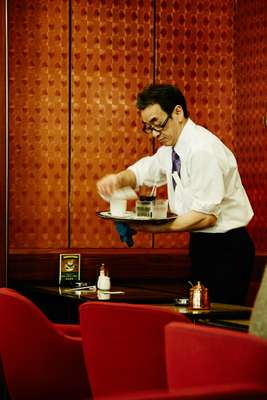
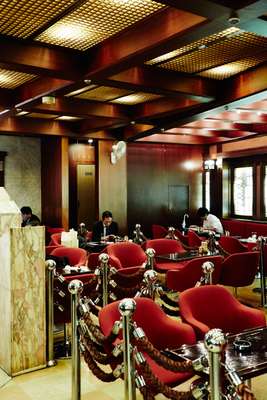
The Café de l’Ambre (amber being the colour of coffee) menu is filled with café classics that won’t be in Starbucks anytime soon. The sweet Blanc et Noir is made with hot coffee that is chilled by rolling it in a metal shaker on a block of ice kept inside an ice box, a common sight before fridges became widespread.
There are anywhere from 20 to 30 types of bean on offer from all over the world, as well as a mellow house blend. “People have different palates – you have to listen to what they want. Maybe something short and bitter after a meal, or sweet if tired,” says Fujihiko Hayashi, Sekiguchi’s nephew. Like a skilled wine maker, Sekiguchi judges that some beans would suit ageing and sets them aside. The oldest is a Cuban bean from 1950. Sekiguchi thought about travelling to Europe until he was told repeatedly by foreign customers that his coffee was better than much of what is being served abroad.
Unusually, Café de l’Ambre doesn’t do food. The traditional kissaten menu has older Japanese swooning with nostalgia, a specific mix of western dishes that like coffee, Japan has made its own. The staples are sandwiches, particularly egg sandwiches – tamago-sando – and thick white toast, usually part of the “morning set” breakfast menu. Some also offer an old-school “Napolitan” tomato spaghetti or an omuraisu (rice-filled omelette). The drinks menu likely features a milkshake (nothing like the western milkshake, the classic kissaten version is a whisked mix of raw egg, milk and sugar) and a melon float, which is a scoop of ice cream atop a green fizzy drink. There might even be a highball, since whisky is another feature of many kissaten menus.
At Coffee Lawn in Yotsuya, owner Hiroaki Ogura turns out a first-rate egg sandwich, made with freshly cooked omelettes layered between slices of crustless white bread. Ogura’s father started the shop in 1954, moved into a new building across the road in 1968 and Coffee Lawn (whose old shop had a small garden) has been there ever since. Ogura started working alongside his father in 1970 and today he runs the place with his wife Chizuko, working from 07.30 to 20.00.
There can be a handcrafted, specialised aspect to some kissaten but in many the appeal is the celebration of the familiar and everyday. The coffee menu at Coffee Lawn is refreshingly short. “I serve ordinary coffee [futsu no kohee],” says Ogura. He pours his coffee through a nel filter and his café au lait is done kissaten-style: stirred over heat in a saucepan, half milk, half coffee. An “American” coffee is listed as “weak coffee”. “My policy is to preserve the same method and taste that this place had 60 years ago,” says Ogura. “I’m not going to change it now.” There’s an element of modesty of course, since he takes pride in his coffee and uses only nel filters made by his daughter, saying that paper filters wouldn’t give the same depth to the flavour.
When the earthquake struck in March 2011, Ogura stayed open until 03.00, offering shelter to people who couldn’t get home that night. “A kissaten is for the community,” he says. “The shop manager in a coffee chain doesn’t have the authority to do something like that but we run our own business.” He laughs as he recalls offering young people use of his telephone, one of the old pink payphones, which were once a feature of every bar and restaurant in Japan. Many didn’t realise what this antiquated piece of equipment was even for.
Regulars still make up half his clientele but recently he has noticed a new audience that enjoys the café’s authentic retro interior, which hasn’t changed in 45 years. Young customers find the vintage styling of the kissaten a revelation after the sameness of the chains.
Another café celebrated for its architecture is Stone, which sits inside the Yurakucho Building, a 1960s block in a busy business district. Stone is run by Masayo Okumura, whose grandmother started the café in 1966 when she was widowed with a family to support. Her family ran a stone business, hence the stone floor of the interior that is often used as a backdrop for fashion shoots. Okumura’s father also ran the place but she is now in sole charge with staff who have been working at Stone for years.
Okumura is aware that she has inherited an architectural gem. Aside from replacing the much-loved chairs, she hasn’t renovated. “My customers ask me not to change anything,” she says. “But it can be a hard balance.” Demolition is always in the air for buildings of this vintage in Tokyo, and Okumura is quick to remind her landlord, Mitsubishi Estate, how popular the café is. Her chef – one of those loyal staff members – suggested reintroducing the classic fruits-sando, a sandwich made with white bread, cream, pineapple and banana. It’s a hit with young customers seeking a taste of retro Tokyo, but regulars still form the backbone at Stone though. Many sip their regular coffee in their usual seat and leave the money on the table.
Kissaten owners know they can’t compete with chains, and now even cheaper conbini convenience-store coffee, on price. They don’t want to be compared, preferring to take pride in what they do and providing a different service, complete with wet hand towels and refills of iced water. “Customers use the kissaten in a different way from the chains,” says Okumura. Stone is regularly used for business meetings and job interviews. She thinks about her customers, even going to a Ginza music shop to find just the right jazz soundtrack.
Numbers of kissaten are down and the future is uncertain. The prized central locations leave owners open to unmanageable rent hikes and inheritance tax can make handing on the business costly. The Tokyo chapter of the Kissaten Association has 200 members (where it used to have 2,000) and there is an annual shindig where kissaten owners from around Japan get together. Their big fear is that smoking, a feature of most kissaten, will be banned. “It’s unthinkable that Stone wouldn’t allow smoking at all,” says Okumura, who has nonetheless introduced a small no-smoking section. Everyone says the chain-coffee boom in Japan has peaked but there are still 275 Starbucks and 385 branches of Doutor in Tokyo alone. The new third-wave coffee scene has brought a whole other café style to Tokyo which, as ever, is receptive to novelty.
The kissaten has always been about more than the coffee; even Sekiguchi, of the aged beans, agrees. “You don’t just serve coffee,” he says. “There’s something else. A comfortable ambience, staff who enjoy their work, conversation, magazines and newspapers, music – each one has its own style.” The owners show a level of dedication that is classic Japanese kodawari: pursuit of perfection. They are guardians of an unheralded culture that could disappear if coffee globalisation continues unchecked. As Sekiguchi says, “I can’t imagine kissaten existing anywhere else.”
Enduring appeal
With imports reaching record levels in 2013 – almost 505,000 tonnes – Japan shows no sign of reducing its coffee consumption. Canned coffee from vending machines and cheap conbini convenience store coffee have their place but they can’t replace the café experience. Kissaten numbers have dwindled but there is still an older clientele who appreciate what an independent coffee shop can offer and a younger audience keen to learn. Even the big chains are having to respond to the demand for more individuality. The coffee shop has a long history in Japan and it might yet surprise us.
Fiona Wilson has been Monocle's burea cheif in Tokyo since launch, when our operation in the city consisted of... her. (Today we have four full-time staff on the magazine, plus the retail team and our sister team from Wink.) Wilson or "Wilo" to those who dare, went to Japan a decade ago "for a few weeks" and has never left (there's a facility in London that still houses her "temporarily" stored possessions - let her know if you need any retro outfits). She is that rarest of journalists: someone who is as good at quizzing a foreign policy wonk as hunting down the best katsu curry.


